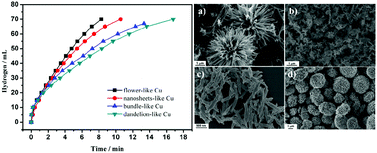Methanolysis of ammonia borane by shape-controlled mesoporous copper nanostructures for hydrogen generation†
Abstract
Diverse mesoporous CuO nanostructures have been prepared by a facile and scaleable wet-chemical method and reduced to mesoporous Cu nanostructures by using the reductant ammonia borane (AB). These mesoporous Cu nanostructures have been applied as a catalyst for hydrogen generation from the methanolysis of AB. The catalytic results show that the reaction rate and the amount of hydrogen evolution significantly relied on their morphologies. Compared with the nanosheet-like, bundle-like and dandelion-like Cu, the flower-like Cu nanostructures exhibit the highest catalytic activity with a total turnover frequency (TOF) value of 2.41 mol H2 mol catalyst−1 min−1 and a low activation energy value of 34.2 ± 1.2 kJ mol−1 at room temperature. Furthermore, the flower-like Cu nanostructures have also shown excellent activity in recycling tests. The low cost and high performance of Cu nanocatalysts may offer high potential for its practical application in hydrogen generation from the methanolysis of AB.


 Please wait while we load your content...
Please wait while we load your content...